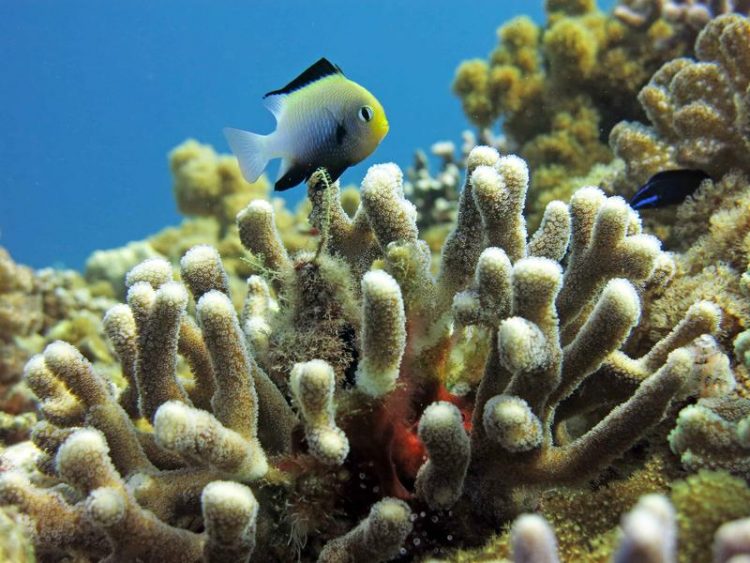Ventilation for corals: Symbiosis with damselfish brings great advantages for coral growth

Red Sea dascyllus among the branches of a Stylophora coral Nur Garcia, Leibniz Centre for Tropical Marine Research
Coral reefs are highly complex communities with multifaceted interrelations and dependencies, many of which are not yet thoroughly studied. The mutually beneficial symbiosis between clownfish and anemones is well known: the fish provide nutrients to their host while at the same time finding a place to hide from predators inside the anemone.
The same advantages are attributed to the symbiosis between damselfish and stony corals. It is strikingly noticeable, however, how tirelessly the damselfish flick their fins when they are hiding among the coral branches. They display this behaviour not just during the day, but also whilst sleeping at night.
Ecologist Nur Garcia and her colleagues from the ZMT have studied this symbiosis in more details. In the Red Sea near Eilat (Israel) they observed the damselfish, Dascyllus marginatus, which frequently resides inside colonies of the branching Stylophora pistillata coral. “More than 30% of the fish’s time is spent among the coral branches”, explains Garcia. “Often a dozen damselfish or more are gathering like a cloud above the football-sized coral.”
In the lab the scientists brought fish and corals together in a respiration chamber to measure respiration and photosynthesis rates. Garcia obtained some unexpected results: Even a single damselfish intermittently visiting the coral increased the photosysnthesis rate of Stylophora by up to 6% a day. Corals that live in symbiosis with damselfish can thus potentially grow considerably faster.
Tiny algae living inside the tissue of stony corals are responsible for the photosynthesis. Their products such as high-energy sugars are beneficial for the corals, allowing them to build the large calcium carbonate structures typical for tropical reefs. During the night corals take up oxygen, in the daytime they emit it during photosynthesis. If an excess of oxygen accumulates, a particular enzyme essential for photosynthesis is inhibited in its activity.
“By flicking its fins the damselfish improve the water circulation as well as the supply and removal of oxygen, which is extremely important in areas of low flow such as lagoons enclosed by reefs,” says Dr. Sebastian Ferse, a reef ecologist who headed the study at the ZMT.
The symbiosis could also have a positive effect during coral bleaching. Stressful conditions such as increased water temperatures can lead to the production of oxygen radicals by the coral, which foster bleaching. The fin flicking can aid in the removal of such radicals.
“However, increased overfishing could spell doom for the symbiosis”, cautions Ferse. “If damselfish predators, i.e. bigger fish, are increasingly caught, the damselfish do not need to hide among the corals any longer.”
“The symbiotic damselfish are also popular ornamental fish and are caught for the marine aquarium trade. In the Thousand Islands archipelago near Jakarta several species have already disappeared,” says Ferse.
Contact:
Dr. Sebastian Ferse | Leiter AG Nutzung, Resilienz und Diversität von Korallenriffen
Leibniz-Zentrum für Marine Tropenforschung (ZMT)
Email: sebastian.ferse@leibniz-zmt.de | Tel: 0421 – 238 00-28
Bis Montag, den 22.5.17 zu erreichen unter: 0049 (0) 157 72379259
Dr. Susanne Eickhoff | Presse-und Öffentlichkeitsarbeit
Leibniz-Zentrum für Marine Tropenforschung (ZMT)
Email: susanne.eickhoff@leibniz-zmt.de | Tel: 0421 – 238 00-37
About the Leibniz Centre for Tropical Marine Research
In research and education the Leibniz Centre for Tropical Marine Research (ZMT) in Bremen is dedicated to the better understanding of tropical coastal ecosystems. As an interdisciplinary Leibniz institute the ZMT conducts research on the structure and functioning of tropical coastal ecosystems and their reaction to natural changes and human interactions. It aims to provide a scientific basis for the protection and sustainable use of these ecosystems. The ZMT works in close cooperation with partners in the tropics, where it supports capacity building and the development of infrastructures in the area of sustainable coastal zone management. The ZMT is a member of the Leibniz Association.
http://jeb.biologists.org/content/220/10/1803
https://www.nature.com/articles/n-12293530
Media Contact
More Information:
http://www.leibniz-zmt.deAll latest news from the category: Life Sciences and Chemistry
Articles and reports from the Life Sciences and chemistry area deal with applied and basic research into modern biology, chemistry and human medicine.
Valuable information can be found on a range of life sciences fields including bacteriology, biochemistry, bionics, bioinformatics, biophysics, biotechnology, genetics, geobotany, human biology, marine biology, microbiology, molecular biology, cellular biology, zoology, bioinorganic chemistry, microchemistry and environmental chemistry.
Newest articles

NASA: Mystery of life’s handedness deepens
The mystery of why life uses molecules with specific orientations has deepened with a NASA-funded discovery that RNA — a key molecule thought to have potentially held the instructions for…

What are the effects of historic lithium mining on water quality?
Study reveals low levels of common contaminants but high levels of other elements in waters associated with an abandoned lithium mine. Lithium ore and mining waste from a historic lithium…

Quantum-inspired design boosts efficiency of heat-to-electricity conversion
Rice engineers take unconventional route to improving thermophotovoltaic systems. Researchers at Rice University have found a new way to improve a key element of thermophotovoltaic (TPV) systems, which convert heat…



